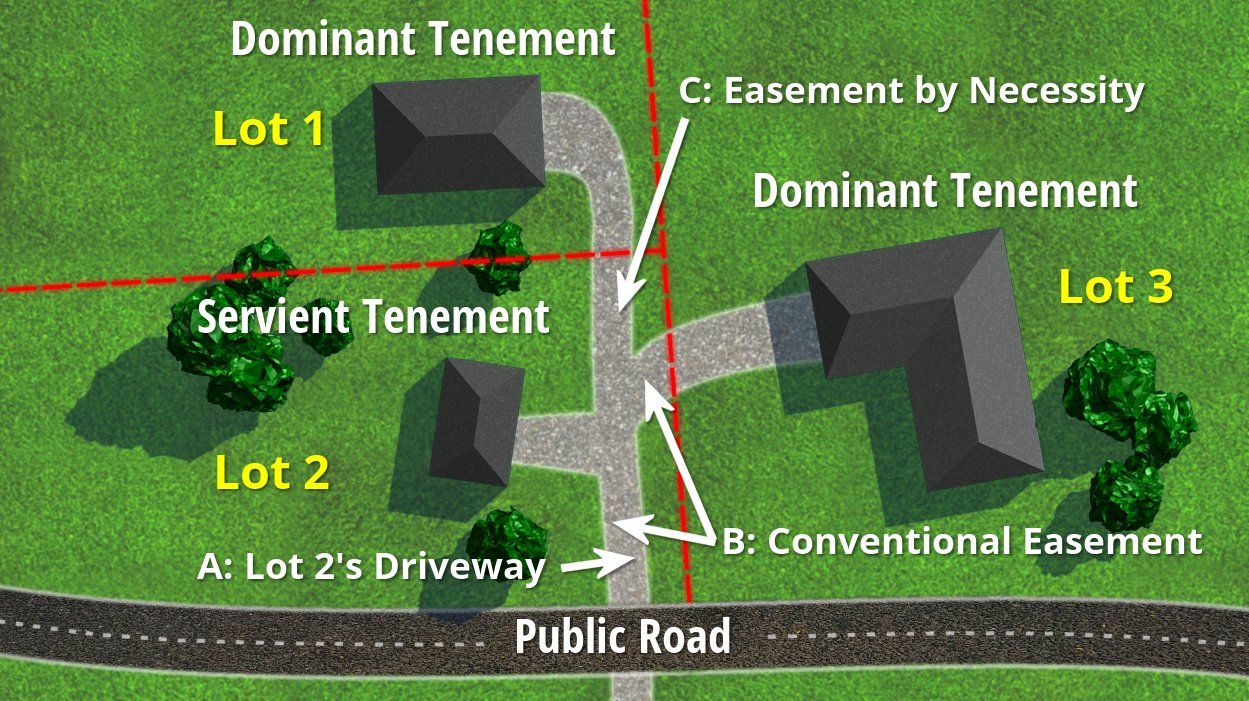An easement appurtenant gives a property owner a right of usage to portions of an adjoining property
By Jeff Sorg, OnlineEd Blog
(April 5, 2019)
(PORTLAND, Ore.) OnlineEd – An easement appurtenant gives a property owner a right of usage to portions of an adjoining property owned by another party. Stated another way, an easement appurtenant is an easement over one parcel that benefits another parcel of land. The property benefiting from the usage right to travel over the easement is called the dominant tenement, or dominant estate. It is called the dominant estate because it is the parcel of real property that has an easement over another piece of property – it dominates. The property that includes the physical easement, that is, the land over which the dominant tenement can travel, is called the servient tenement since it must serve the dominant estate by providing the easement for its use.
The term appurtenant means “attaching to.” An easement appurtenant, then, attaches to the estate and transfers with it unless expressly stated otherwise. More specifically, the easement attaches as a beneficial interest to the dominant estate, and as an encumbrance to the servient estate. Accordingly, the easement appurtenant becomes part of the dominant estate’s bundle of rights and an obligation or encumbrance of the servient estate.
Transfer. Easement appurtenant rights and obligations automatically transfer with the properties, either the dominant or servient estate, whether or not mentioned in the deed.
Non-exclusive use. Both the servient tenement and dominant tenement can use the easement, provided the servient’s usage does not unreasonably obstruct the dominant’s use.

The exhibit shows a conventional easement appurtenant. The driveway marked A belongs to Parcel #2. An easement appurtenant, marked B on the diagram, allows Parcel #3 to use #2’s driveway. Parcel #3 is the dominant tenement, and Parcel #2 is the servient tenement.
Easement by necessity. An easement by necessity is an easement appurtenant legally granted by a court to a property owner because of necessity. Usually, the necessary condition that precipitates the granting of the easement is the need to provide ingress and egress to a property. Ingress means a way to travel into the property, and egress means a way to travel out of the property. Since a property cannot be landlocked and must have access to a public thoroughfare, the court will grant an owner of a landlocked property an easement by necessity over an adjoining property that already has access to a thoroughfare. When this is the case, the landlocked party becomes the dominant tenement, and the land over which the easement is granted is called the servient tenement. In the exhibit, Parcel #1, which is landlocked, owns an easement by necessity, C, across Parcel #2.
Party wall easement. A party wall is a common wall shared by two separate structures along a property boundary. Party wall agreements generally provide for severalty ownership of half of the wall by each owner, or at least some fraction of the width of the wall. Ownership in severalty means individual ownership; ownership is “severed” from all others. Also, the agreement grants a negative easement appurtenant to each owner against the other owner’s wall. A negative easement gives each party the right to restrain or control the use of the other party’s use in some way, such as unlimited use of the wall or a destructive use that would jeopardize the adjacent property owner’s building. The party wall easement also establishes responsibilities and obligations for the maintenance and repair of the wall.
Other structures that are subject to party agreements are common fences, driveways, and walkways. Common means they are shared between the properties – they are of common or shared ownership and on the property line between the affected properties.
++ Remember: A negative easement appurtenant does not allow the owner of the dominant estate to cross over the servient estate. Instead, the dominant estate has the right to restrict some activity or use of the servient estate.

(Image ©Copyright, OnlineEd, Inc. All Rights Reserved)
A negative easement appurtenant does not allow the owner of the dominant estate to cross over the servient estate. Instead, the dominant estate has the right to restrict some activity or use of the servient estate. Example: Developer Jovan purchased a tract of land abutting Oceanfront Lake and divided it into two parcels. Lot A is on the shoreline, and Lot B is farther back from the shore. Lot B has a good view of the lake because it is situated on higher ground that overlooks Lot A, but it is located behind Lot A and could be lost if Lot A builds a two-story house. Because Jovan wants the best price for each parcel, the view of the lake from Lot B is protected by adding a deed restriction in Lot A’s deed to limit any structure built on Lot A to a single story.
In the example above, the owner of Lot B is the owner of a negative easement appurtenant. The dominant estate, Lot B, can prohibit specific activity on Lot A, the servient estate, that could block or restrict the view of the lake. In this situation, Lot B’s owner does not have an affirmative easement appurtenant and cannot cross over the land of Lot A to reach the lake, since only the view is protected. Though not applicable to the above example, it is possible to have both an affirmative and negative easement at the same time. If an easement was created for access to the lake and to limit the height of any structure, then the owner of Lot B would have both negative and affirmative easements.
Easements appurtenant are created in these ways:
By grant or reservation – An easement created by grant or reservation is created by the express written agreement of the landowner. This is most frequently done in the deed but can be done in a separate recorded instrument. When done by grant, the owner of a property gives to someone else the easement right. When done by reservation, the owner of the property retains an easement on land conveyed to another. For example, you sell your property but keep the right to travel over the sold parcel to walk to the ocean.
By intent or necessity – The right to ingress (entry) and egress (exit) is required by law. Any property that is landlocked, meaning it has no ingress and egress, has these rights. A landlocked landowner has a right to an easement to cross the land of another to reach a public right-of-way. This type of easement available to a landlocked owner is called an easement by necessity and is outlined in Oregon Revised Statutes, specifically ORS 376. The servient estate in the easement by necessity may be entitled to compensation for the easement.
By prescription – An easement by prescription is the use of the land of another that meets these requirements;
- Open and notorious (obvious to anyone);
- Actual, continuous (uninterrupted for the entire required period);
- Adverse to the rights of the true property owner;
- Hostile (in opposition to the claim of another, not “hostile” in the ordinary sense); and
- Continuous for a statutorily defined period (10 years in Oregon).
An easement by prescription gives the dominant tenant the right of use of the property, not ownership of the property.
By implication – An easement by implication arises out of the conduct of the parties. This means it is an implied easement, not a written easement. An easement by necessity is distinguished from an easement by implication in that the easement by necessity arises only when “strictly” necessary. In contrast, the easement by implication can occur when “reasonably” necessary. For example, the right lot owners have in a subdivision to use a roadway on the approved subdivision plan without requiring a specific grant or easement to each new lot.
By condemnation – The government’s right to use the land of an owner is created by the exercise of the government’s right of eminent domain. Eminent domain includes not only the right of the government to obtain an ownership interest in the property of a private owner; it also provides for the right of the government to create a use easement over the land of a private property owner to benefit the government-owned land. For example, the US Bureau of Land Management uses its power of eminent domain to create an easement of right of way over private property to access government-owned, but landlocked forestland.
Easements appurtenant can be terminated by one of these ways:
- Release of the easement by the dominant owner
- Merging the dominant and servient lands into one tract
- Abandonment of the easement by the dominant owner
- The reason the easement was created no longer exists
- Expiration of the time for which the easement was given
©OnlineEd; All rights reserved.
###
OnlineEd blog postings are the opinion of the author and not intended as legal or other professional advice. Be sure to consult the appropriate party when professional advice is needed.
For more information about OnlineEd and their education for real estate brokers, principal brokers, property managers, and mortgage brokers, visit www.OnlineEd.com.
All information contained in this posting is deemed correct as of the date of publication, but is not guaranteed by the author and may have been obtained from third-party sources. Due to the fluid nature of the subject matter, regulations, requirements and laws, prices and all other information may or may not be correct in the future and should be verified if cited, shared, or otherwise republished.
OnlineEd® is a registered Trademark


